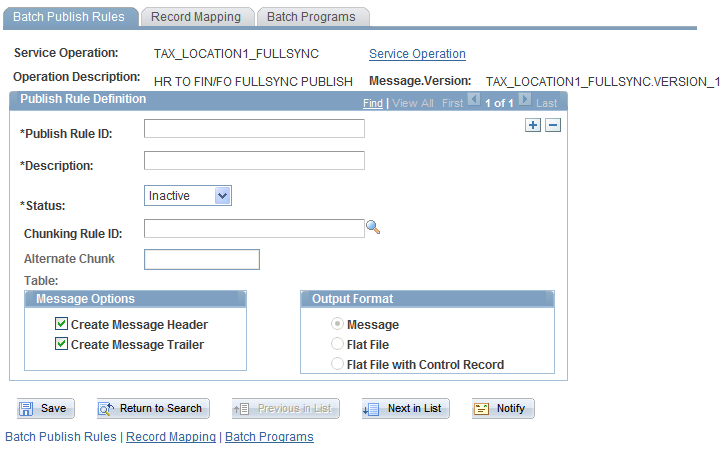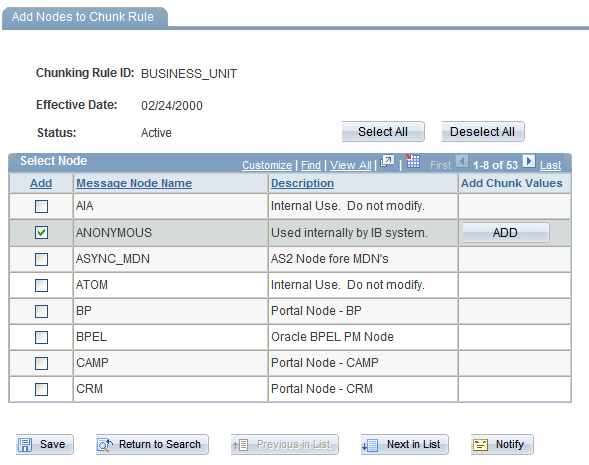Setting Up PeopleSoft Integration Points
This section discusses how to:
Set up publication rules.
(Optional) Map nodes to a chunking rule.
(Optional) Assign business units or setIDs to a chunking rule.
Specify OnRoute PeopleCode.
Note: For more information and technical details about these integration points, and for information about how and with what applications to use them, consult the relevant application documentation.
Pages Used to Set Up PeopleSoft Integration Points
|
Page Name |
Definition Name |
Navigation |
Usage |
|---|---|---|---|
|
Batch Publish Rules |
EOIU_SOPUBATCH |
|
Set up publication rules. You must activate a publication rule for the publication messages that you create to follow. This rule includes instructions on message chunking. |
|
Add Nodes to Chunk Rule |
EOIU_ADNODECHUNK_PNL |
|
Map PeopleSoft message nodes to chunking rules. |
|
Batch Publish |
EOIU_BATCHPUB |
|
Create the run control for the batch publish process. |
Batch Publish Rules Page
Use the Batch Publish Rules page (EOIU_SOPUBATCH) to set up publication rules.
You must activate a publication rule for the publication messages that you create to follow. This rule includes instructions on message chunking.
Image: Batch Publish Rules page
This example illustrates the fields and controls on the Batch Publish Rules page. You can find definitions for the fields and controls later on this page.

If the data that you’re transmitting does not fit in a single message, or if you want to send different parts of the message to different target systems, set up the rules to chunk the message and associate it with the publish rule. The business unit and setID chunking rules are standard in PeopleSoft applications, but you can configure chunking rules.
Message Options
Many PeopleSoft systems rely on a message header and message trailer to trigger subscription PeopleCode to discard old table data and insert the new incoming data. As a general rule, all FullSync messages should use a header and trailer. Sync messages don’t need headers and trailers.
Output Format
The Application Engine program used to chunk messages can create either an XML message that flows through messaging architecture or a flat file that is generated in PeopleSoft Process Scheduler and not published elsewhere. Always select Message as the format when you send data to PeopleSoft systems.
Add Nodes to Chunk Rule Page
Use the Add Nodes to Chunk Rule page (EOIU_ADNODECHUNK_PNL) to map PeopleSoft message nodes to chunking rules.
Image: Add Nodes to Chunk Rule page
This example illustrates the fields and controls on the Add Nodes to Chunk Rule page. You can find definitions for the fields and controls later on this page.

To map nodes to a chunk rule:
In the Add column, select the check box next to the nodes that you defined earlier.
After you select a node, use the Add button in the Add Chunk Values column to open the Quick Map page for the message you defined earlier.
Click Save.
Specifying OnRoute PeopleCode
Create a service operation handler to route the message chunk to the correct subscriber node.
To do so, extend the IRouter application class and use the OnRouteSend method. Then in the appropriate service operation, define a handler and specify the application class.